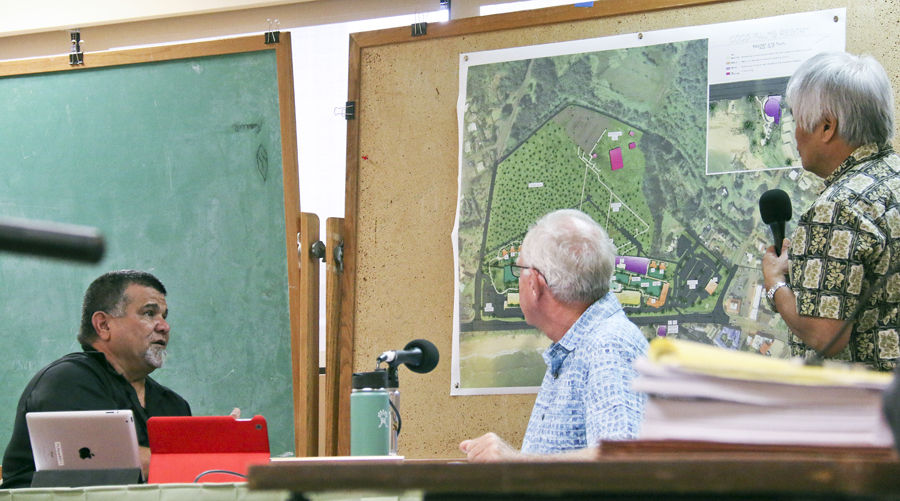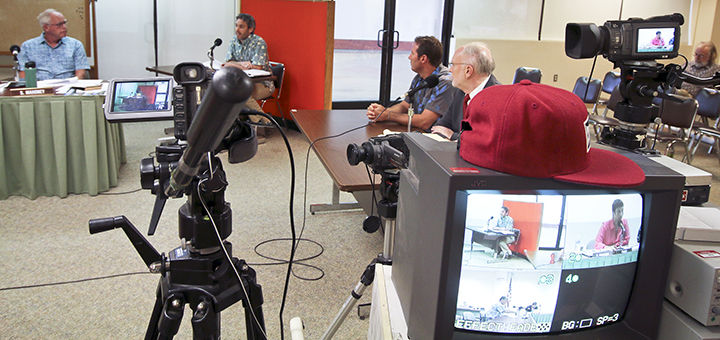LIHUE — Future concerns about traffic and pedestrian safety along Kuhio Highway stalled more than just early morning and afternoon commuters on Tuesday. The seven-member Kauai Planning Commission deferred any decisions on current Coco Palms Hui, LLC plans to reconstruct
LIHUE — Future concerns about traffic and pedestrian safety along Kuhio Highway stalled more than just early morning and afternoon commuters on Tuesday.
The seven-member Kauai Planning Commission deferred any decisions on current Coco Palms Hui, LLC plans to reconstruct and restore the Coco Palms Resort in Wailua until their March 10 meeting so they can receive more information on options to mitigate traffic impacts.
It is a move that, county planning officials and commissioners say, is necessary to ensure that no future problems arise from past decisions and actions.
“From our understanding of just plain common sense, when you have a situation where you have a hotel across from a highway and then there’s a beach that your customers are going to want to go to, that’s going to have an impact,” Planning Commission Chair Angela Anderson said. “So we’re trying to really foresee what are the things we can help shape to lessen that impact as much as possible.”
State Department of Transportation spokesman Derek Inoshita said plans are in place to add an additional lane to the mauka side of Kuhio Highway from the Kapaa Bypass Road to Kuamoo Road.
The nearly $40 million construction project, he said, is expected to begin next year and be completed by 2017.
“The state is currently working with the community and businesses throughout the corridor to develop traffic solutions,” Inoshita wrote in an email.
Planning Commissioners Louis Abrams and Jan Kimura said they support project plans but are concerned about how traffic from the resort will impact the Kapaa corridor.
“I want to see this project move forward, so I don’t want any hiccups, and I’m trying to prevent hiccups from becoming involved in the future,” Kimura said. “It has been way too long for this building to sit idle, and I think it’s a great idea. It’s just that I hope we can somehow work together and get this thing going up ASAP.”
Coco Palms Hui, LLC Principal Tyler Greene said hotel traffic mitigation plans include the use of a continuously running shuttle that would take customers between the Sea Shell Restaurant and the hotel property across Kuhio Highway. The hotel, he added, would also offer bike rentals so guests can access Ke Ala Hele Makalae, the county’s paved coastal path, to reach destinations in Wailua and Kapaa.
“Even though it is situated in such a difficult spot with regards to congestion, it is located right across the street from a beautiful beach of which many resort users will use and access either by shuttle or by walking,” SSFM International, Inc. Traffic Engineer Mike Packard said. “It’s also located on a shared-use bike path, so to the degree that Kauai has limited transit options through bus and other measures, the opportunity is there for the users of Coco Palms to just walk or bike to where they want to go.”
The hotel, according to plans, would also have five entrance and exit points to help alleviate traffic along nearby roadways, including two one-way entrance and exit areas from Kuhio Highway.
Still, Greene said, there may be other short-term solutions that may help ease traffic congestion along the highway at certain times of the day, such as working with state Department of Transportation officials to decrease the signalization time of stoplights at key intersections and explore more contraflow options.
“We’re all saying the same things, and in our opinion, traffic is a problem and we wouldn’t argue to the contrary because we’ve sat in it — we’ve been through those things,” Greene said. “I’ve sat at those intersections, whether it was walking, biking, or in a car and rushing to go to Lihue for meetings in the morning.”
Coco Palms Hui, LLC attorney Michael Belles said building a pedestrian walkway over Kuhio Highway that would connect the resort to Wailua Beach may create more harm than good during the construction phase and prove to be costly for state and county officials as they try to prioritize future traffic improvements.
County Planning Director Michael Dahilig said specific timelines for developers to obtain certain permits, as well as begin and cease construction, have been incorporated as conditions to the Planning Commission’s approval to ensure that the project moves forward, following several failed attempts over the years.
“A lengthy delay in rehabilitating the site since the hurricane has left a lot of people with a bit of a bitter taste in their mouth — it has just been bare and rotting away for over two decades,” Dahilig said. “We are acutely aware that many in the community want to see action and don’t want to see just simply a permit issued and having it sit for a number of years.”




